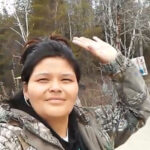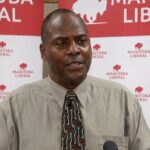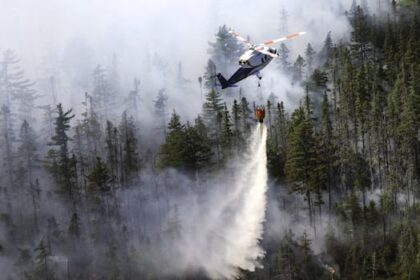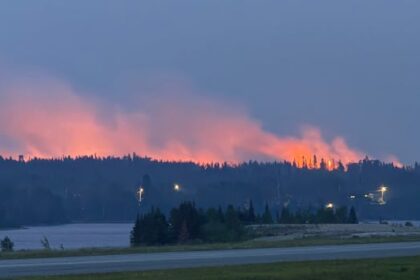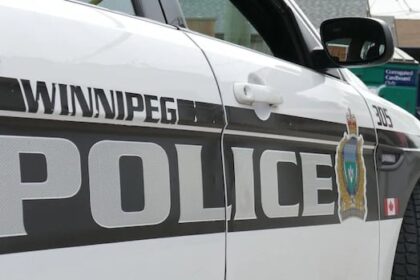Nova Scotia·NewThe Wolastoqey Nation in New Brunswick’s Aboriginal title case is entering its fifth year, but some worry that reconciliation won’t happen in a courtroom.Battle for Aboriginal title is ongoing raising questions on reconciliation in the legal systemSis’moqon · CBC News · Posted: Sep 29, 2025 7:11 PM EDT | Last Updated: 19 minutes agoThe Wolastoq River is at the heart of the Wolastoqey Nation’s Aboriginal Title Case. Each of the six Wolastoqey communities in New Brunswick are situated along the river, and traditionally the Nation relied on the river for trade routes, and food gathering. (CBC/Joe Fiorino)The Wolastoqey Nation in New Brunswick is entering its fifth year of litigation against the province, seeking recognition of Aboriginal title to more than half the land in New Brunswick. The Nation maintains that it never surrendered title of its ancestral lands and waters when it signed the Peace and Friendship Treaties with the British Crown in the 18th century. The lands in question involve both privately held land and Crown land, but the Nation says they aren’t going after homeowners or municipalities. “If you are not named in the case, then you’re not part of the title claim,” said Chief Patricia Bernard.Bernard knows the long road of litigation well. As a young law student in 1996, she filed a specific land claim on behalf of her community, Madawaska Maliseet First Nation, about 270 km northwest of Fredericton. Madawaska Maliseet First Nation Chief Patricia Bernard is one of six Wolastoqey chiefs involved in the Aboriginal title case. (Joe Fiorino/CBC)The case carried on for nearly 25 years before finally being resolved in 2021, resulting in a $145 million settlement and 783 hectares of land to add to its reserve. But this case is different. Unlike a specific claim – where Canada breaches a lawful obligation – this Aboriginal title claim is seeking recognition of the Nation’s inherent rights to its traditional homelands. For the specific claim in Madawaska, Canada was found to have breached its lawful obligation to the First Nation by transferring lands meant for the First Nation to a third party, creating what is now known as Edmundston. Proving Aboriginal title The courts rely on the Delgamuukw test, established by the Supreme Court in 1997. To prove Aboriginal title a Nation must show: Occupation of the land prior to Crown sovereignty. Continuous occupation or “substantial connection” to the land. Exclusive occupation at the “assertion of sovereignty”. In New Brunswick, that assertion of sovereignty was declared in 1759. “That’s why these cases take so long,” said Bernard.”We need to collect evidence to show where the Wolastoqey were in 1759.”What were the parts of their territory… how they were using their territory… and that they were using their territories to the exclusion of other Indigenous nations.”The Wolastoqey Nation in New Brunswick announced that they have filed a notice of intent to pursue an Aboriginal title claim for the Wolastoq, or St. John River, and its tributaries and lands. (Wolastoqey Nation in New Brunswick)The Wolastoqey named both the Crown and six major industries in the province in their case. Last year, a judge removed the industry defendants, ruling the dispute lies between the Crown and the Nation. After the companies’ lands were not also dropped from the case, the companies appealed the decision, leaving the case temporarily at a standstill. River at the heart of the caseThe Wolastoq River, known as the St. John River despite efforts to return to its traditional name, is at the heart of the Nation’s claim. Elder Edward Perley says the river has sustained the Wolastoqey for generations, providing food, transportation and fresh water.Perley said the Wolastoqey people are so interconnected with the river that they are named for it as “the people of the beautiful and bountiful river.”It connects each of the six Wolastoqey communities in the province, all situated along its banks. “The connection to the water, connection to land is very vital and important to our existence of who we are,” said Perley, of Nekotkuk (Tobique First Nation).Edward Perley, Elder-in-residence with the Wolastoqey Nation in New Brunswick, believes that if the Nation is successful in their case, they will have a voice when it comes to what type of industry is introduced in their territory. (Joe Fiorino/CBC)Perley recalls growing up fishing and hunting along the river, but over time he said his people were denied access as non-Indigenous settlers claimed ownership of surrounding areas.”We no longer had access… you know, the connection to the water, connection to land is very vital and important to our existence of who we are,” said Perley.”We were never included in any kind of decisions when it came to the land that’s situated in New Brunswick.”[If the case succeeds] it will change that when big industries come in and try to abstract minerals from the land, that they’ll also have to consult with our communities.”Aboriginal title and reconciliationAs Canada approaches the tenth anniversary of the Truth and Reconciliation Commission’s 94 Calls to Action, progress remains uneven, with less than 20 fully implemented. One unresolved call, specifically addresses Aboriginal title and urges governments and courts to recognize occupation-based claims and shift the burden of proof onto parties who seek to prove any limitation of rights.For Wolastoqey Nation lawyer, Renée Pelletier, that call to action is crucial.”We’re still really at the infancy stages [of our case] which I think really speaks to how the court process is maybe not the best way to achieve reconciliation,” said Pelletier.”The spirit of [that call to action] is really calling on the federal and provincial governments like the Crown to sit down and to try to resolve issues outside of the courtroom.”Pelletier said having First Nations go through the courts, sometimes for decades, spending millions, is not conducive to a pathway to reconciliation.ABOUT THE AUTHORSis’moqon is a Mi’kmaw woman from Ugpi’ganjig First Nation. She is a reporter with CBC Indigenous. She currently resides in Kjipuktuk, also known as Halifax. You can email her at sis.moqon@cbc.ca with story ideas.
Saturday, 15 Nov 2025
Canada – The Illusion
Search
Have an existing account?
Sign In
© 2022 Foxiz News Network. Ruby Design Company. All Rights Reserved.
You May also Like
- More News:
- history
- Standing Bear Network
- John Gonzalez
- ᐊᔭᐦᑊ ayahp — It happened
- Creation
- Beneath the Water
- Olympic gold medal
- Jim Thorpe
- type O blood
- the bringer of life
- Raven
- Wás’agi
- NoiseCat
- 'Sugarcane'
- The rivers still sing
- ᑲᓂᐸᐏᐟ ᒪᐢᑿ
- ᐅᑳᐤ okâw — We remember
- ᐊᓂᓈᐯᐃᐧᐣ aninâpêwin — Truth
- This is what it means to be human.
- Nokoma



